Best solutions.Graded A+
One-Stop-Shop For The Latest Proctored Exams, ATI, HESI, NCLEX, TEAS, OCR, AQA, I-Human, Test Banks, Essays, Lecture Notes, Books, Study Guides, & Other Academic Prerequisites On Any Subject. Get the best study guides with verified solutions. I only offer the best documents with an approval rate exceeding 95%.
- 591
- 0
- 0
Community
- Followers
- Following
1 Reviews received
591 items
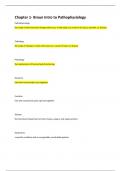
Chapter 1- Braun Intro to Pathophysiology Download To Score An A+
Pathophysiology the study of the functional changes that occur in the body as a result of an injury, disorder, or disease Pathology the study of changes in cells and tissues as a result of injury or disease Physiology the mechanisms of human body functioning Structure how the human body is put together
- Exam (elaborations)
- • 8 pages •
Pathophysiology the study of the functional changes that occur in the body as a result of an injury, disorder, or disease Pathology the study of changes in cells and tissues as a result of injury or disease Physiology the mechanisms of human body functioning Structure how the human body is put together

Braun Applied Pathophysiology - Chapter 6: Genetic and Developmental Disorders Graded A+
What is DNA? Where is it found? What is it responsible for? What are the 4 nitrogenous bases? 1. Deoxyribonucleic acid. 2. Cell nucleus and Mitochondria 3. The storage of genetic information 4. Purines (Adenine - Guanine), Pyrimidines (Cytosine - Thymine) A-T C-G (Base pairs) What are Genes? Where are Genes located? What are Genes made up of? 1. Small functional hereditary units 2. Specific site of a chromosome 3. DNA What do most Genes contain? 1. Genes contain the information o...
- Exam (elaborations)
- • 17 pages •
What is DNA? Where is it found? What is it responsible for? What are the 4 nitrogenous bases? 1. Deoxyribonucleic acid. 2. Cell nucleus and Mitochondria 3. The storage of genetic information 4. Purines (Adenine - Guanine), Pyrimidines (Cytosine - Thymine) A-T C-G (Base pairs) What are Genes? Where are Genes located? What are Genes made up of? 1. Small functional hereditary units 2. Specific site of a chromosome 3. DNA What do most Genes contain? 1. Genes contain the information o...
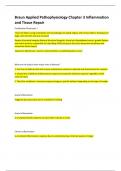
Braun Applied Pathophysiology Chapter 3 Inflammation and Tissue Repair Rated A+
Proliferative Phase part 1 -Clear the debris using neutrophils and macrophages to engulf, digest, and remove debris. Healing can't begin until necrotic cells are removed Restore Structural Integrity-Restore Structural integrity- tissue lysis (breakdown) occurs; growth factors and matrix proteins responsible for rebuilding ECM (structures that cells-basement membrane and connective tissue layers) -Basement Membrane- must be restored before re-epithelialization occurs What are the body's ...
- Exam (elaborations)
- • 20 pages •
Proliferative Phase part 1 -Clear the debris using neutrophils and macrophages to engulf, digest, and remove debris. Healing can't begin until necrotic cells are removed Restore Structural Integrity-Restore Structural integrity- tissue lysis (breakdown) occurs; growth factors and matrix proteins responsible for rebuilding ECM (structures that cells-basement membrane and connective tissue layers) -Basement Membrane- must be restored before re-epithelialization occurs What are the body's ...
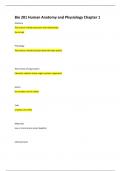
Bio 201 Human Anatomy and Physiology Chapter 1 Score An A+
Anatomy The science of body structures and relationships (to cut up) Physiology The science of body functions (how the body works) The 6 levels of organization Chemical, cellular, tissue, organ, system, organismal Atoms the smallest unit of matter
- Exam (elaborations)
- • 13 pages •
Anatomy The science of body structures and relationships (to cut up) Physiology The science of body functions (how the body works) The 6 levels of organization Chemical, cellular, tissue, organ, system, organismal Atoms the smallest unit of matter
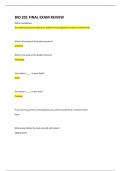
BIO 201 FINAL EXAM REVIEW Fully Solved Solution Rated A+
Define metabolism: the chemical processes that occur within a living organism in order to maintain life. What is the study of the bodies structure? Anatomy What is the study of the bodies function? Physiology Your ankle is ____ to your thigh? Distal The elbow is ____ to the wrist? Proximal
- Exam (elaborations)
- • 19 pages •
Define metabolism: the chemical processes that occur within a living organism in order to maintain life. What is the study of the bodies structure? Anatomy What is the study of the bodies function? Physiology Your ankle is ____ to your thigh? Distal The elbow is ____ to the wrist? Proximal

BATES TEST BANK Question And Answers Rated A+
tenderness You are assessing a patient with joint pain and are trying to decide whether it is inflammatory or noninflammatory in nature. Which one of the following symptoms is consistent with an inflammatory process? A) Tenderness B) Cool temperature C) Ecchymosis D) Nodules lupus You are assessing a patient with diffuse joint pains and want to make sure that only the joints are the problem, and that the pain is not related to other diseases. Which of the following is a systemic cause ...
- Exam (elaborations)
- • 59 pages •
tenderness You are assessing a patient with joint pain and are trying to decide whether it is inflammatory or noninflammatory in nature. Which one of the following symptoms is consistent with an inflammatory process? A) Tenderness B) Cool temperature C) Ecchymosis D) Nodules lupus You are assessing a patient with diffuse joint pains and want to make sure that only the joints are the problem, and that the pain is not related to other diseases. Which of the following is a systemic cause ...

Bates - Chapter 1 - Physical Examination and History Taking Download Score An A+
When would you conduct a comprehensive assessment vs focused? Comprehensive -> new pt. -> very sick -> strengthen pt-ph relationship -> get baselines for future reference Focused -> established pt. routine visits -> focused concerns/symptoms Subjective vs Objective data subjective -> what the pt. tells you, chief complaint, history etc objective -> what you detect during the exam
- Exam (elaborations)
- • 3 pages •
When would you conduct a comprehensive assessment vs focused? Comprehensive -> new pt. -> very sick -> strengthen pt-ph relationship -> get baselines for future reference Focused -> established pt. routine visits -> focused concerns/symptoms Subjective vs Objective data subjective -> what the pt. tells you, chief complaint, history etc objective -> what you detect during the exam

ATI Predictor Practice Exam 1 Best Solution Graded A+
A nurse is caring for a newborn whose parents asks why the baby is receiving vitamin K. The newborn should receive vit K to prevent which of the following? a. Bleeding b. Potassium deficiency c. Infection d. Hyperbilirubinemia a. Bleeding Newborns should receive vit K at birth bc they have low levels of it, which can lead to bleeding A charge nurse is observing a new nurse admin enteral feeding via an NG tube. Which of the following actions by the new nurse indicates understanding of th...
- Exam (elaborations)
- • 5 pages •
A nurse is caring for a newborn whose parents asks why the baby is receiving vitamin K. The newborn should receive vit K to prevent which of the following? a. Bleeding b. Potassium deficiency c. Infection d. Hyperbilirubinemia a. Bleeding Newborns should receive vit K at birth bc they have low levels of it, which can lead to bleeding A charge nurse is observing a new nurse admin enteral feeding via an NG tube. Which of the following actions by the new nurse indicates understanding of th...

ATI Med-Surg Proctored Exam Review Latest Solution Rated A+
Respiratory Alkalosis S/S lethargy lightheadedness confusion tachycardia dysrhythmias related to hypokalemia nausea vomiting epigastric pain numbness and tingling of the extremities hyperventilation (tachypnea) A nurse is contributing to the plan of care for an older adult client who is at risk for Osteoporosis. Which intervention should the nurse include to prevent bone loss? Encourage weight bearing exercises (such as walking because it can help maintain bone mass by reducing bon...
- Exam (elaborations)
- • 18 pages •
Respiratory Alkalosis S/S lethargy lightheadedness confusion tachycardia dysrhythmias related to hypokalemia nausea vomiting epigastric pain numbness and tingling of the extremities hyperventilation (tachypnea) A nurse is contributing to the plan of care for an older adult client who is at risk for Osteoporosis. Which intervention should the nurse include to prevent bone loss? Encourage weight bearing exercises (such as walking because it can help maintain bone mass by reducing bon...
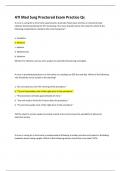
ATI Med Surg Proctored Exam Practice Qs Fully Solved Solution
A nurse is caring for a client who experienced a traumatic head injury and has an intraventricular catheter (Ventriculostomy) for ICP monitoring. The nurse should monitor the client for which of the following complications related to the ventriculostomy? a. Headache b. Infection c. Aphasia d. Hypertension b. Infection Monitor for infection and use strict asepsis to avoid life-threatening meningitis. A nurse is providing education to a client who is to undergo an EEG the next day. Which ...
- Exam (elaborations)
- • 29 pages •
A nurse is caring for a client who experienced a traumatic head injury and has an intraventricular catheter (Ventriculostomy) for ICP monitoring. The nurse should monitor the client for which of the following complications related to the ventriculostomy? a. Headache b. Infection c. Aphasia d. Hypertension b. Infection Monitor for infection and use strict asepsis to avoid life-threatening meningitis. A nurse is providing education to a client who is to undergo an EEG the next day. Which ...

TNCC test prepA, TNCC Notes for Written Exam, TNCC Notes for Written Exam,/ TNCC Prep/, TNCC EXAM, TNCC 8th Edition